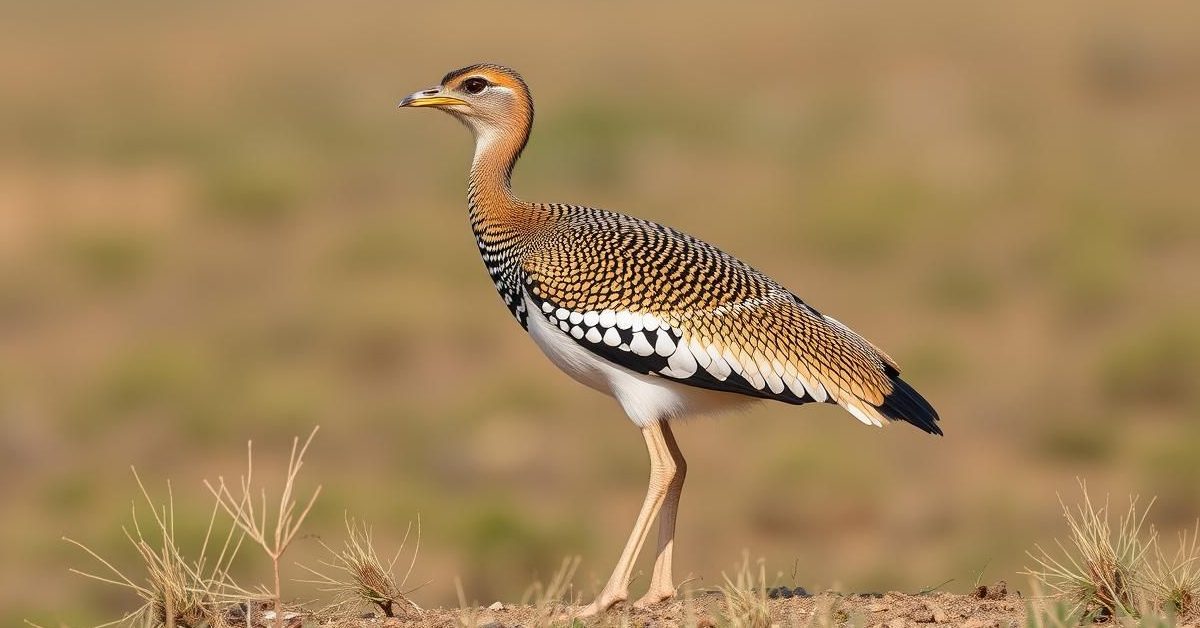India’s critically endangered Great Indian Bustard (GIB) is once again in the spotlight as a Supreme Court-appointed expert committee proposes “power corridors” in its habitats to balance renewable energy development with urgent conservation needs.
The Bustard’s Plight and the Court’s Intervention
The Supreme Court recently revisited its 2021 directive, which mandated all overhead power lines in GIB habitats be buried underground. This earlier order faced challenges regarding its technical and economic viability, particularly for renewable energy companies operating in Rajasthan and Gujarat.
In response, an expert committee was tasked with finding a middle ground. Their proposal includes designated power corridors for transmission lines, aiming to protect the GIB while allowing essential energy infrastructure to develop.
Meet the Great Indian Bustard
The Great Indian Bustard is an iconic and exceptionally large bird, found exclusively in India. It is the largest of the four bustard species in the country and one of the heaviest flying birds globally. GIBs are primarily terrestrial, preferring vast grasslands as their home.
These birds feed on insects, lizards, and grass seeds. They are considered a flagship species for grasslands, acting as a crucial indicator of the health of these vital ecosystems.
Historically, the GIB’s range spanned much of the Indian subcontinent, but it has shrunk drastically to just 10 percent of its original habitat. With fewer than 150 individuals remaining, the International Union for Conservation of Nature (IUCN) lists the GIB as “Critically Endangered,” pushing it to the brink of extinction.
Key threats include habitat loss due to expanding farmlands, predation of eggs by animals like dogs and monitor lizards, and, significantly, collisions with overhead power lines. The GIB is also the state bird of Rajasthan, home to its largest remaining population.
Fighting for Survival: Conservation Efforts
Efforts to save the GIB began in earnest between 2012 and 2013 with a long-term “Bustard and Lesser Florican recovery project” spearheaded by the Rajasthan government and the Environment Ministry.
This initiative received substantial funding and solidified in 2016. In 2018, a tripartite agreement between the Ministry of Environment, Forest and Climate Change, Rajasthan Forest Department, and Wildlife Institute of India (WII) further strengthened the program.
Key initiatives include establishing conservation breeding centers in Ramdevra and Sorsan, Rajasthan. These centers focus on captive breeding, field research using telemetry for bird tracking, population surveys, and habitat management. Community outreach is also vital to gain local support for conservation.
Future plans for the project, extending until 2033, involve upgrading existing facilities and developing a new lab for artificial insemination, aiming to boost GIB numbers from 2026 onwards.
Balancing Energy and Ecology: New Proposals
The expert committee has proposed revised “priority areas” for GIB conservation: 14,013 sq km in Rajasthan and 740 sq km in Gujarat. These zones are designated for focused protection.
Within these areas, the committee suggests specific power corridors: 5 km wide in Rajasthan and 1-2 km wide in two separate zones in Gujarat. These corridors aim to guide new transmission lines away from critical habitats while allowing existing ones to be assessed individually.
Mitigation measures include immediate burying of certain high-risk power lines and assessing others based on voltage. The committee also proposed a “jump start” method for Gujarat’s GIB population, involving incubating eggs from conservation centers using wild GIB females and tagging existing birds for monitoring.
- The Great Indian Bustard is critically endangered, with fewer than 150 birds remaining.
- It is a flagship species for grassland ecosystems, indicating their health.
- Major threats include habitat loss, predation, and collisions with power lines.
- Conservation efforts include breeding programs and habitat management.
- A Supreme Court expert committee proposed power corridors to balance energy development with GIB protection.
As the world celebrates World Nature Conservation Day, the spotlight on the Great Indian Bustard reminds us of the continuous, delicate balance required to protect our planet’s invaluable biodiversity for generations to come.















